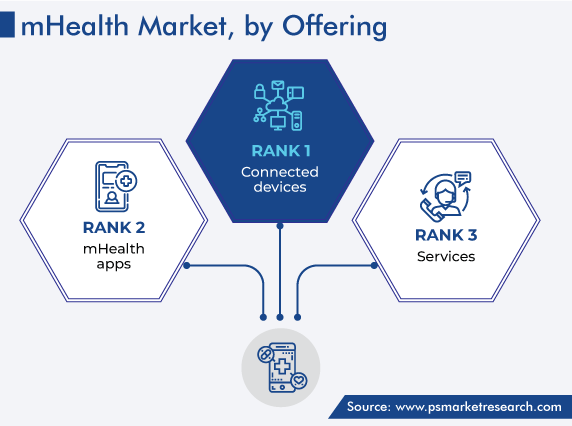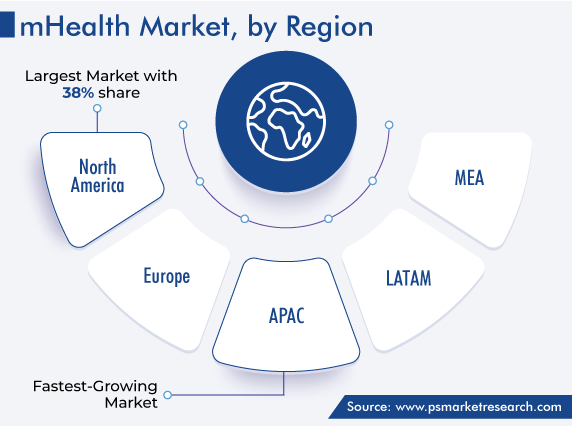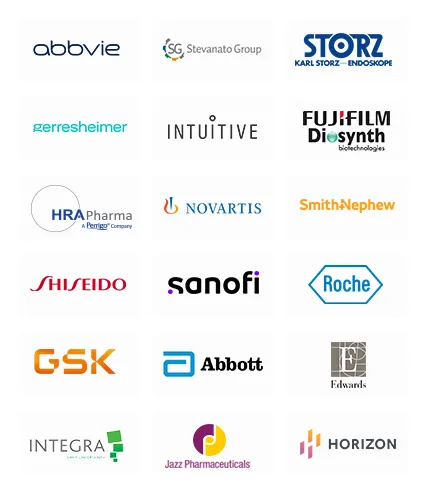Market Statistics
| Study Period | 2019 - 2030 |
| 2024 Market Size | USD 70.1 Billion |
| 2030 Forecast | USD 154.1 Billion |
| Growth Rate(CAGR) | 14% |
| Largest Region | North America |
| Fastest Growing Region | Asia-Pacific |
| Nature of the Market | Fragmented |
Report Code: 10224
Get a Comprehensive Overview of the mHealth Market Report Prepared by P&S Intelligence, Segmented by Offering (Connected Devices, Services, mHealth Apps), Stakeholder (Mobile Operators, Device Vendors, Application/Content Players, Healthcare Providers), and Geographic Regions. This Report Provides Insights from 2019 to 2030.
| Study Period | 2019 - 2030 |
| 2024 Market Size | USD 70.1 Billion |
| 2030 Forecast | USD 154.1 Billion |
| Growth Rate(CAGR) | 14% |
| Largest Region | North America |
| Fastest Growing Region | Asia-Pacific |
| Nature of the Market | Fragmented |

Explore the market potential with our data-driven report
The global mHealth market generated revenue of USD 70.1 billion in 2024, which is expected to witness a CAGR of 14% to reach USD 154.1 billion by the end of this decade. This can be ascribed to the surge in the penetration of smartphones, tablets, and other mobile communication platforms, along with that of connected medical devices and mHealth apps. Furthermore, the growing geriatric population and chronic disease prevalence, rising demand for remote patient monitoring services, and mounting focus on patient-centric healthcare services are driving the market.
The increasing penetration of tablets and smartphones in various developed as well as developing economies is a key factor driving the industry growth. Mobile users are rapidly switching to smartphones due to the availability of affordable 3G and 4G spectra. This rising penetration of smartphones, coupled with the growing awareness of the various advantages of these devices and services, including preventive care, will drive the demand for them.
Furthermore, the penetration of wireless communication technologies is no more limited to developed countries. The growth in mobile phone ownership is further set to continue as cell phones are now common in countries such as Kenya and Nigeria too. Smartphone apps facilitate self-monitoring for patients, wherever they are.
According to the University of Michigan National Poll, nearly three in ten adults aged 50–80 (28%) are using mobile health apps. These users include healthcare professionals, consumers, and patients. Thus, this growing adoption of digital platforms is expected to drive the demand for mobile healthcare solutions in developed as well as developing countries.
Globally, there has been an increase in the need for remote patient monitoring solutions, mainly due to the surging geriatric population and lack of primary healthcare facilities in the remote areas of developing nations. Remote patient monitoring helps in reducing the overall care cost by collecting the health-related data of patients from home, through platforms connected to the database of the care provider. Moreover, players in the market are introducing various medical devices that, when connected to the internet, enable remote patient monitoring.
The connected devices category accounted for the largest revenue share, of around 48%, in 2022, and it is further expected to maintain its position during the prediction period. This can be ascribed to the growing internet penetration, rising usage of smartphones and tablets, escalating need for improved patient care, surging demand for a lower cost of care, and strong focus on real-time disease management. In addition, the rapid population growth, surge in the incidence of various lifestyle-associated diseases, growth in the trend of home-based diagnoses, and rapid implementation of EHRs are driving the uptake of connected medical devices.
Among the various kinds of network-connected medical devices, blood pressure monitors held the major revenue share in 2022, and they are expected to dominate the market in the forecast period too. This can be attributed to the surging consumer preference for home-based monitoring, rising number of product launches by industry players, and increasing number of hypertension cases across the globe.
Furthermore, mHealth apps will register the fastest growth in the coming years. This is due to the increasing focus of industry players on developing healthcare apps that focus on patient data management and evaluation. Additionally, the increasing prevalence of chronic diseases, widespread use of remote patient care technologies, burgeoning adoption of such apps on the suggestion of doctors, to enhance clinical outcomes and boost patient involvement, and booming trend of fitness apps are behind the surge in the downloads of mHealth applications.
Of the two types of such apps, the healthcare category accounted for the larger revenue share in 2022, and it is expected to maintain its position during the prediction period. This can be attributed to the surging incidence of chronic diseases among the elderly population, rising preference for convenient health solutions, and high internet as well as smartphone penetration.
The service category also contributed significant revenue in 2022. This can be attributed to the increasing requirement for remote monitoring, online consultation, healthcare surveillance, and emergency response; surging number of outpatient settings, rising need for regularly tracking patients’ health, and mounting number of government initiatives to spread awareness on overall health.
Furthermore, the category is further divided into remote monitoring, diagnosis and consulting, treatment, healthcare system strengthening, fitness and wellness, and preventive services. Among these, remote monitoring accounted for the major share in 2022, and it is further anticipated to dominate the market during this decade. This is mainly due to the growing adoption of these services to monitor patients’ conditions, even in the remote areas of developing as well as developed countries.

With the evolution of IT, there has been a rise in the preference for patient-centric healthcare models. Although hospitals and other medical institutions, such as ambulatory surgery centers (ASCs) and private clinics, maintain extensive patient records, including lab reports, ongoing treatment processes, and prescribed medications, it is not possible for patients to access such information every time, especially if they are remotely located or traveling.
Here, portable communication devices, such as smartphones and tablets, provide access to patients to their health records, which can encourage proactive and preventive care. Moreover, mobile devices include various features, such as Bluetooth, location sensing, and apps, which can help users track exercise and get medication reminders.
Patients are increasingly willing to be monitored wirelessly at home, rather than receiving traditional hospital-based care. Moreover, mHealth solutions enable patients to book appointments, obtain test results, and access medical records.
Mobile operators accounted for the largest revenue share, of 51%, in 2022, and they are further expected to maintain their dominance during the forecast period. This can be ascribed to the increase in the number of subscribers, continuous improvement in the network infrastructure, rise in the adoption of the 4G and 5G technologies, and increase in the count of industry consolidation activities.
Additionally, the healthcare providers category will witness significant growth in the coming years. This is due to the surging need for improved and cost-effective medical infrastructure, increasing number of industry players, rising pace of technological advancements in the healthcare sector, and growing consumer consciousness toward health and related products.
Whereas, the application/content players category will register the fastest growth owing to the mounting number of connected devices, growing consumer engagement, and increasing need for improved customer support. Moreover, the mounting adoption of the mobile health technology and increasing awareness regarding the benefits of the related apps in remote patient monitoring contribute to the category’s growth.
Drive strategic growth with comprehensive market analysis
North America accounted for the largest revenue share, of around 38%, in 2022, and it is further expected to maintain its dominance during the forecast period. This can be ascribed to the rising healthcare expenditure, increasing number of chronic disease cases, booming elderly population, and well-developed network infrastructure. Furthermore, the growing burden of CVDs and rising count of in-hospital patients boost the regional market advance. Additionally,
Europe also contributed significant revenue to the market in 2022. This was due to the high rate of adoption of advanced technologies and infrastructure development and the presence of a significant number of industry players. In addition,
APAC will witness the fastest growth in the coming years, with a CAGR of 14.7%. This can be ascribed to the mounting investments by the major players in HIT solutions due to the increase in the healthcare expenditure in the developing economies of the region and increasing prevalence of chronic diseases. Moreover,

This fully customizable report gives a detailed analysis of the mobile health industry from 2019 to 2030, based on all the relevant segments and geographies.
Based on Offering
Based on Stakeholder
Geographical Analysis
The market for mHealth solutions valued 70.1 billion in 2024.
The mHealth industry 2024–2030 CAGR will be 14%.
The major drivers for the market for mHealth solutions are the rising internet and smartphone penetration and growing chronic disease burden.
Connected devices are the highest mHealth industry revenue generators.
Players in the market for mHealth solutions have numerous opportunities in the U.S., Germany, India, China, and South Korea.
Want a report tailored exactly to your business need?
Request CustomizationLeading companies across industries trust us to deliver data-driven insights and innovative solutions for their most critical decisions. From data-driven strategies to actionable insights, we empower the decision-makers who shape industries and define the future. From Fortune 500 companies to innovative startups, we are proud to partner with organisations that drive progress in their industries.


Working with P&S Intelligence and their team was an absolute pleasure – their awareness of timelines and commitment to value greatly contributed to our project's success. Eagerly anticipating future collaborations.
McKinsey & Company
IndiaOur insights into the minutest levels of the markets, including the latest trends and competitive landscape, give you all the answers you need to take your business to new heights
We take a cautious approach to protecting your personal and confidential information. Trust is the strongest bond that connects us and our clients, and trust we build by complying with all international and domestic data protection and privacy laws
Customize the Report to Align with Your Business Objectives
Request the Free Sample Pages